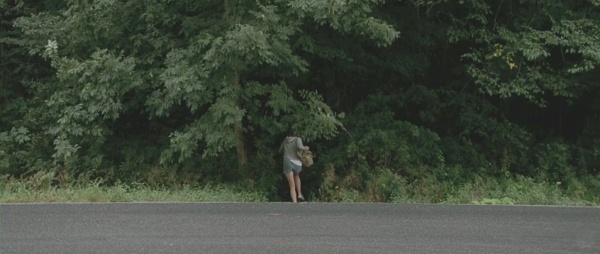2011 // USA // Sean Durkin // December 6, 2011 // Theatrical Print (Landmark Tivoli Theater)
Sean Durkin’s unsettling, skillfully crafted debut feature, Martha Marcy May Marlene, offers abundant moments of skin-crawling tension. However, it’s not quite accurate to describe the film as a thriller. That generic tag suggests the primacy of a propulsive narrative and stunning reversals, features which the film pointedly lacks. What it in fact presents is a character study of an abused and harrowed psyche, a study that places the viewer deep inside the titular Martha’s dazed, fearful headspace with disquieting ease. The terrors that the film presents are the terrors of the past, which seep up through the ground and distort the present into a narcotic haze. Fully half of the film takes place in flashback, as Martha recalls her horrific experiences in a Manson-like pseudo-spiritual criminal cult. The achievement of the film lies in the befuddled immediacy of Martha’s remembrances, which scramble past and present and leave her (and the viewer) in a state of perpetual raw-nerved paranoia. It is, in essence, an immersive portrait of post-traumatic stress disorder, deftly realized in cinematic form.
The film opens with Martha’s (Elizabeth Olsen) hasty, surreptitious flight on foot from a rural commune, where what little we see—women toiling in mute subservience to the men—suggests something Not Quite Right. Cult member Watts (Brady Corbet) quickly catches up with Martha in town and lays some vague menace on her, but she nonetheless manages to place a tearful call to her estranged older sister, Lucy (Sarah Paulson), who shows up a few hours later and whisks Martha away. This sets up the rest of the film’s framing narrative, in which a shell-shocked Martha takes up hesitant residence at the massive, dreadfully tasteful lakeside summer home of Lucy and husband Ted (Hugh Dancy). There she attempts—with little success—to re-acclimate to the outside world and shake the unnerving sensation that she is being watched. These scenes at the lake house are intercut with flashbacks which gradually reveal the hellish extent of the traumas Martha suffered while in the fold of the cult.
Underneath a flimsy veneer of wooly New Age positivity and utopianism, the cult is exposed as a witch’s brew of misogyny and cynical criminality, all roiling around the father figure of Patrick (John Hawkes), a charming tyrant who viciously rapes each female recruit under the guise of "cleansing" them. The tactics that the cult utilizes to control its members are as old as the hills—a toxic mingling of love, reward, and fear designed to remake each captive into their own jailer—but the film wisely devotes ample time to observing exactly how such emotional terrorism unfolded in Martha’s specific case. This is essential, as it allows the viewer to appreciate Martha’s actions as reasonable given her situation, neatly heading off the incredulous objections that inevitably sprout in any abuse scenario ("Why didn’t she just leave?"). Moreover, the flitting between past and present highlights Martha’s discomfort with the wider world, not to mention her still-fresh dread after escaping a nightmarish situation. Several moments will often pass before it is clear whether a new scene is a flashback or not, a confusion abetted by the film’s often purposely ambiguous framing, lighting, and design. For Martha, the past isn’t even past.
Unfortunately, Lucy and Ted, while initially charitable and patient, are a tad too self-absorbed and suffused with bourgeois sanctimony to provide Martha with the empathy she desperately needs. (They are, after all status-obsessed yuppies, which under the conventions of American indie film marks them as, at best, clueless obstacles to the main character's liberation.) The film is vague about Martha's life prior to the cult, suggesting only that it was lonely and troubled. By lecturing her about her lack of ambition and strange behavior, Lucy and Ted provide Martha with daily reminders of why Patrick's superficially loving and accepting ideology proved so enticing. In her defense, Big Sis is operating under limited information. Martha offers Lucy virtually no explanations for where she has been, even as signs surface that the cult has followed and is now watching her. Panicked second-guessing prevails: Are the nocturnal taps on the roof dropping pinecones, or are they pebbles tossed by cultists, mimicking a common diversion they employed during their bloody home invasions? Martha’s comfort with life in her sister’s house wanes just as her paranoia waxes, leading to an outright meltdown when she mistakes a bartender at a party for a cult spy.
Events eventually spiral towards a conclusion that crackles with tension, although the film refuses to decisively resolve the story. Martha isn't exactly an unreliable narrator; rather, the ominous signs that crowd the final minutes of the film can reasonably be interpreted as either meaningless occurrences or the telltale rustles of something Very Bad that is about to go down. Like this year's definitive American film, Meek's Cutoff, the non-ending of Martha will likely frustrate some viewers accustomed to more concrete resolutions. While Martha never discovers the former film's philosophical, historical, and mythic depth, the thrust of its final moments is similarly devastating. To a mind battered by trauma—war, torture, abuse—there is no discernible difference between a stranger sitting on the beach and a murderous fanatic bent on dragging you back to Hell.




